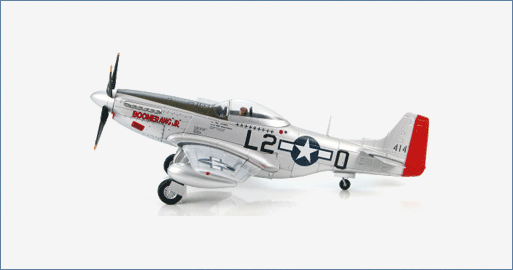Air Power Series>1:48 die-cast display model>P-51>HA7723A
P-51D Mustang "BOOMERANG JR" flown by Col. Arthur 'Art" Jeffrey, 434th FS, 479th FG, Dec 1944

General Background
Later in WWII the Allied bombers were flying deep into Germany but suffered tremendous losses because of the lack of range the fighter escorts had. German fighters would wait beyond the range of the Allied fighters and then attack the vulnerable bombers. Once the P-51 called Mustang by the British had the Allison engine replaced with a British Merlin it possessed the high performance that had been lacking. With drop tanks the P-51 had the range to escort bombers all the way to Berlin and back.
The Aircraft
Mr. Paul Poberezny is a man with an astonishing background. Mr. Poberezny spent 30 years in
the U.S. Military as a pilot, test pilot and survived WWII and the Korean Conflict. When Lt. Col.
Poberezny retired he had the distinction of being the only person to receive all 7 military aviation
wings - glider pilot, service pilot, rated pilot, liaison pilot, senior pilot, Army aviator and command
pilot. Paul Poberezny was the founder of the EAA (Experimental Aircraft Association). The Paul I
P-51D was manufactured as 44-75007 but after WWII it became N5462V. In 1963 the aircraft had
a Cavalier Aircraft conversion to a 2-seater and became N3451D. In 1966 the aircraft was owned
by Trans Florida Aviation Inc., Sarasota FL. In 1969 N3451D became the property of Tempress
Research C. Corp. of Sunnyvale CA. In the early 1970's the aircraft was used as an air-racer
#96 before it finally went to the EAA of Oshkosh, WI in 1977. Here it received a yellow nose and
blue scheme like another P-51D "Lou IV". It was also given the code PH-P and the name "Paul I".
The aircraft flew until August 2, 1982 when on that day during a flight the engine started to
sputter and Paul Poberezny realized that if he didn't end up crash landing the aircraft too much
historical value that it would go into the Eagle Hangar at the EAA AirVenture Museum in Oshkosh
where it can be seen on display today. Paul Poberezny is believed to be the only living person
that flew every version of the P-51 including the XP-51 prototype which can also be seen at the
EAA AirVenture Museum.
Specifications :
Tasks: |
Dive-bomber, bomber-escort, ground-attack, interceptor, photo recon |
| Number Produced All Variants: | 14,819 |
| Dimensions | |
| Height: | 13 ft 8 in (4.16 m) |
| Wingspan: | 37 ft (11.27 m) |
| Length: | 32 ft 3 in (9.82 m) |
| Weight | |
| Empty: | 7,125 lb (3,232 kg) |
| Gross: | 10,100 lb (4,581 kg) |
| Maximum Take-off: | 11,600 lb (5,262 kg) |
| Performance | |
| Engine: | Packard Merlin two-staged supercharged V-1650-7, 12 cylinder V engine 1,695 hp. |
| Maximum Speed: | 437 mph (703 km/h) |
| Ceiling: | 41,900 ft (12,771 m) |
| Range: | 950 miles (1,529 km) |
| Maximum Range: | 2,300 miles (3,701 km) |
| Armament | (6) .50 caliber MG |
| Maximum External Bomb Load – 2,000 lb (907 kg) | |
| Or (4) .5 inch rockets |

